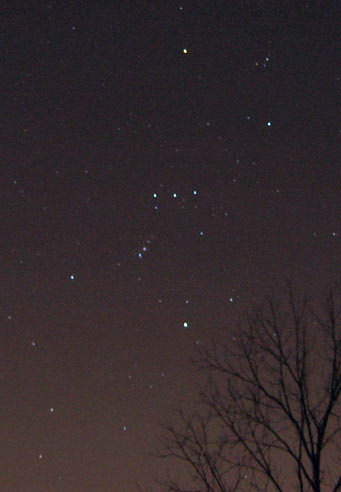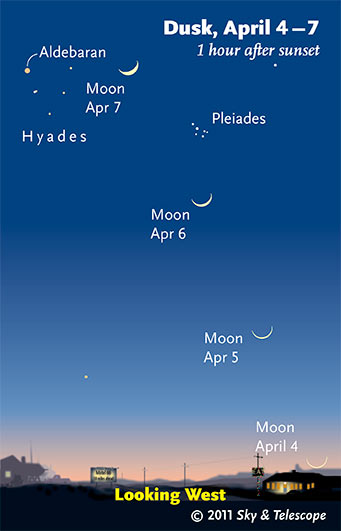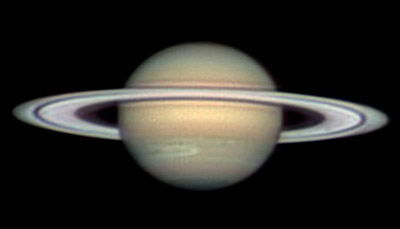
Orion, with belt horizontal, was declining in the southwest when S&T's Tony Flanders took this 15-second exposure with a Canon A80 pocket digital camera.
Tony Flanders
Friday, April 1
Saturday, April 2
Sunday, April 3
Monday, April 4
Tuesday, April 5

Watch the waxing crescent Moon ascend from night to night in the twilight toward the Pleiades and Hyades. (These scenes are drawn for the middle of North America. European observers: move each Moon symbol a quarter of the way toward the one for the previous date. For clarity, the Moon is shown three times actual size.)
Sky & Telescope diagram
Wednesday, April 6
Thursday, April 7
Friday, April 8
Saturday, April 9
Sky at a Glance is now an iPhone app! Put S&T SkyWeek on your iPhone, iPad, or iPod Touch and get the above listings anytime, anywhere — with interactive sky maps! Tap a button to see the scene described, customized for your location worldwide. From there you can scroll the view all around the sky, zoom in or out, change to any time or date, and turn on animation.
Go to Apple's iTunes store from your device to get S&T SkyWeek.
Want to become a better amateur astronomer? Learn your way around the constellations. They're the key to locating everything fainter and deeper to hunt with binoculars or a telescope.
For an easy-to-use constellation guide covering the whole evening sky, use the big monthly map in the center of each issue of Sky & Telescope, the essential magazine of astronomy. Or download our free Getting Started in Astronomy booklet (which only has bimonthly maps).

The Pocket Sky Atlas plots 30,796 stars to magnitude 7.6 — which may sound like a lot, but that's less than one star in an entire telescopic field of view, on average. By comparison, Sky Atlas 2000.0 plots 81,312 stars to magnitude 8.5, typically one or two stars per telescopic field. Both atlases include many hundreds of deep-sky targets — galaxies, star clusters, and nebulae — to hunt among the stars.
Sky & Telescope
Once you get a telescope, to put it to good use you must have a detailed, large-scale sky atlas (set of charts). The standards are the Pocket Sky Atlas, which shows stars to magnitude 7.6; the larger Sky Atlas 2000.0 (stars to magnitude 8.5); and the even larger and deeper Uranometria 2000.0 (stars to magnitude 9.75). And read how to use sky charts effectively.
You'll also want a good deep-sky guidebook, such as Sky Atlas 2000.0 Companion by Strong and Sinnott, or the more detailed and descriptive Night Sky Observer's Guide by Kepple and Sanner, or the classic if dated Burnham's Celestial Handbook.
Can a computerized telescope take their place? I don't think so — not for beginners, anyway, and especially not on mounts that are less than top-quality mechanically. As Terence Dickinson and Alan Dyer say in their Backyard Astronomer's Guide, "A full appreciation of the universe cannot come without developing the skills to find things in the sky and understanding how the sky works. This knowledge comes only by spending time under the stars with star maps in hand."
This Week's Planet Roundup
Mercury is fading out (from magnitude +2 to +4 this week) and disappearing down into the sunset as it nears inferior conjunction.
Venus (magnitude –3.9) is still in the morning sky, shining low in the east-southeast as dawn brightens.
Mars remains out of sight behind the glare of the Sun until summer.
Jupiter is out of sight in conjunction with the Sun.

Saturn on April 5th, just past opposition. The rings are still brighter than usual compared to the globe due to the opposition effect (Seeliger effect); compare with past images (scroll down).
The head of the northern-hemisphere white disturbance had barely crossed the central meridian when Christopher Go shot this image at 14:23 UT; the System III longitude on the central meridian was 222°. South is up.
Note the faint dark spot on the B ring at lower right. Here's an animation of two exposures demonstrating that it's real. In the animation north is up, so look on the rings' left. Go asks, "Is this a spoke or a [satellite] shadow?"
Christopher Go
Saturn (magnitude +0.4, in Virgo) comes to opposition on the night of April 3rd. It glows low in the east-southeast as twilight fades, rises higher in the southeast during evening, and shines highest in the south after midnight. During the evening, look for twinkly Spica 11° below it and brighter Arcturus nearly 30° to its left.
With Saturn so close to opposition, its rings are now displaying the Seeliger effect, whereby they brighten for a few days around opposition due to backscattering of sunlight back toward the Sun and Earth. The solid icy ring particles backscatter, but Saturn's cloudtops do not (or not as much).
The rings are 9° from edge on. Also in a telescope, Saturn's months-old white spot has spread into a light band far around the planet, as seen here. See how many of Saturn's satellites you can identify in your scope using our Saturn's Moons tracker.
Uranus and Neptune are hidden in the glow of dawn.
All descriptions that relate to your horizon — including the words up, down, right, and left — are written for the world's mid-northern latitudes. Descriptions that also depend on longitude (mainly Moon positions) are for North America. Eastern Daylight Time (EDT) equals Universal Time (also known as UT, UTC, or GMT) minus 4 hours.
To be sure to get the current Sky at a Glance, bookmark this URL:
http://SkyandTelescope.com/observing/ataglance?1=1
If pictures fail to load, refresh the page. If they still fail to load, change the 1 at the end of the URL to any other character and try again.
 0
0
Comments
You must be logged in to post a comment.